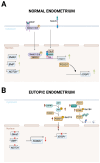Molecular Basis of Impaired Decidualization in the Eutopic Endometrium of Endometriosis Patients
- PMID: 40072055
- PMCID: PMC11899082
- DOI: 10.3390/cells14050326
Molecular Basis of Impaired Decidualization in the Eutopic Endometrium of Endometriosis Patients
Abstract
Endometriosis is a chronic gynecological disorder characterized by the presence of endometrial tissue outside the uterine cavity. A common feature of this pathology is the impaired decidualization of endometrial stromal cells, a critical process that prepares the uterus for embryo implantation. This decidualization defect has been mechanistically linked to progesterone resistance in endometriotic lesions. However, the presence and underlying mechanisms of decidualization defects in the eutopic endometrium of women with endometriosis remain controversial. The aim of the present study is to integrate and discuss molecular evidence from both in vivo and in vitro studies examining decidualization alterations in the eutopic endometrium of patients with endometriosis. Multiple studies have demonstrated impaired decidualization in the eutopic endometrium of women with endometriosis. These alterations have been reported on multiple genes, signaling pathways, and epigenetic processes. However, additional functional studies are warranted to elucidate whether these decidualization defects directly contribute to endometriosis-associated infertility. A better understanding of the decidualization process and its dysregulation in endometriosis will not only advance the development of targeted fertility treatments but also facilitate the design of more effective therapeutic strategies for managing this chronic condition.
Keywords: decidualization; endometrial stromal cells; endometriosis; epigenetics; eutopic endometrium; gene expression; signaling pathway.
Conflict of interest statement
The authors declare no conflicts of interest.
Figures



Similar articles
-
Decreased Notch pathway signaling in the endometrium of women with endometriosis impairs decidualization.J Clin Endocrinol Metab. 2015 Mar;100(3):E433-42. doi: 10.1210/jc.2014-3720. Epub 2014 Dec 29. J Clin Endocrinol Metab. 2015. PMID: 25546156 Free PMC article.
-
Decidualization attenuates the contractility of eutopic and ectopic endometrial stromal cells: implications for hormone therapy of endometriosis.J Clin Endocrinol Metab. 2009 Jul;94(7):2516-23. doi: 10.1210/jc.2009-0207. Epub 2009 Apr 7. J Clin Endocrinol Metab. 2009. PMID: 19351726
-
Steroidogenic enzyme and key decidualization marker dysregulation in endometrial stromal cells from women with versus without endometriosis.Biol Reprod. 2009 Jan;80(1):105-14. doi: 10.1095/biolreprod.108.070300. Epub 2008 Sep 24. Biol Reprod. 2009. PMID: 18815356 Free PMC article.
-
Epigenetic Factors in Eutopic Endometrium in Women with Endometriosis and Infertility.Int J Mol Sci. 2022 Mar 30;23(7):3804. doi: 10.3390/ijms23073804. Int J Mol Sci. 2022. PMID: 35409163 Free PMC article. Review.
-
Molecular mechanism of aberrant decidualization in adenomyosis leading to reduced endometrial receptivity.Front Endocrinol (Lausanne). 2025 Jan 16;15:1435177. doi: 10.3389/fendo.2024.1435177. eCollection 2024. Front Endocrinol (Lausanne). 2025. PMID: 39886033 Free PMC article. Review.
Cited by
-
Endometriotic Follicular Fluid Affects Granulosa Cells' Morphology and Increases Duplication Rate and Connexin-43 Expression.Biomolecules. 2025 Apr 10;15(4):561. doi: 10.3390/biom15040561. Biomolecules. 2025. PMID: 40305294 Free PMC article.
References
Publication types
MeSH terms
Grants and funding
LinkOut - more resources
Full Text Sources
Medical

